I have an old Meade 8" SCT OTA that I've been thinking of putting into service. I've read a lot about the standard Celestron reducer being really awful in the corners with APS-C and larger sensors. I use a very small 585 sensor with requires a good image circle of only 13mm. The question is, would I really see a big difference between the standard reducer or the much more expensive options such as the Starzona or Alan Gee versions?
Hi Tony,
You should be ok with the 585 sensor up to the 533. Some time ago, I've talked with the Celestron support and they told me the corrected image circle (not the illuminated circle) to their corrector (the Celestron reducer/flatnner x0.63) is 15-17mm of correction. So you're ok using their reducer. Above that, you'll star seeing problems.
Best regards,
Cesar
You should be ok with the 585 sensor up to the 533. Some time ago, I've talked with the Celestron support and they told me the corrected image circle (not the illuminated circle) to their corrector (the Celestron reducer/flatnner x0.63) is 15-17mm of correction. So you're ok using their reducer. Above that, you'll star seeing problems.
Best regards,
Cesar
Helpful Concise
Tony Gondola:
That's good news and what I suspected. Thanks for the input Cesar.
I use in mine 4/3 sensors, like the 294MM, 294MC and the 1600MM, and to be honest I only have a just small star aberration in the corners, but nothing that BlurX can't solve. But according to them, the image corrected circle is about that. The 15-17mm ;)
They even asked which sensors I was using, and told me to expect some star aberration with their reducer/flatnner.
In your situation your are ok ;)
Above that, you'll need the Starizona one, but prepare yourself to have some other problems with him, mainly backfocus and focusing room and tilt (if you use the wrong adapters).
Regards,
Cesar
Tony Gondola:
I really would only go with the Starzona option option if I needed to. I've had a close look at your M-101 image using it with a micro 4/3 sensor and it looks fine. Do You remember if correction was used with BlurX?
Yes, I used BlurXTerminador.. I had too mainly because when I took that photo, I was still finding the proper backfocus in my setup at the time through ASTAP. And it was not the 105mm of backfocus as Celestron told. I found the correct backfocus and correct focal lenght at 112.1mm.
There's a thread a while back that I think it can help you regarding the Starizona reducer/flatnner. I think is this one: https://www.astrobin.com/forum/c/astrophotography/equipment/27-tilt-on-my-celestron-imaging-train/
Just read carefully everything if you're planning to go with the Starizona.
Regards,
Cesar
Supportive
I was still finding the proper backfocus in my setup at the time through ASTAP. And it was not the 105mm of backfocus as Celestron told. I found the correct backfocus and correct focal lenght at 112.1mm.
Can you tell me how ASTAP can calculate proper back-focus?
I have both reducers and am thinking of trying the Celestron with my 533 because the Starizona is only F7.15 (1450mm @ 0.53”/px) while the celestron is a true F6.3 (1280mm @ 0.6”/px).
Hello John,
I think I didn't make myself clear regarding the use of ASTAP to calculate the backfocus. I use it as the plate solver in my capture software (I use the AstroPhotography Tools - APT) with some of Star databases in the ASTAP. Some of the libraries are H18, H17, D50, D05, etc. Hope this helps: https://sourceforge.net/projects/astap-program/files/star_databases
I'll leave two prints of my software in how I do it:
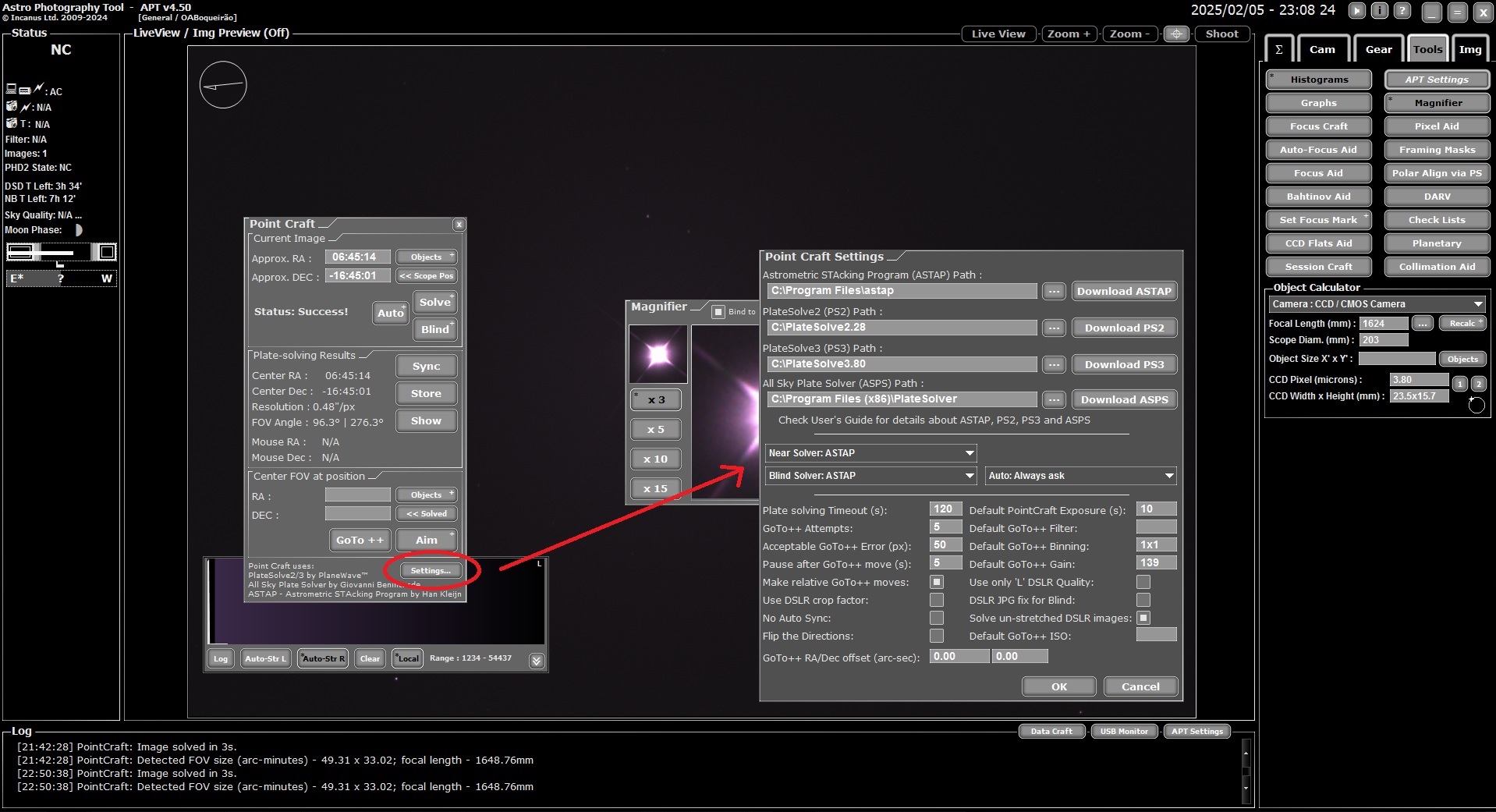
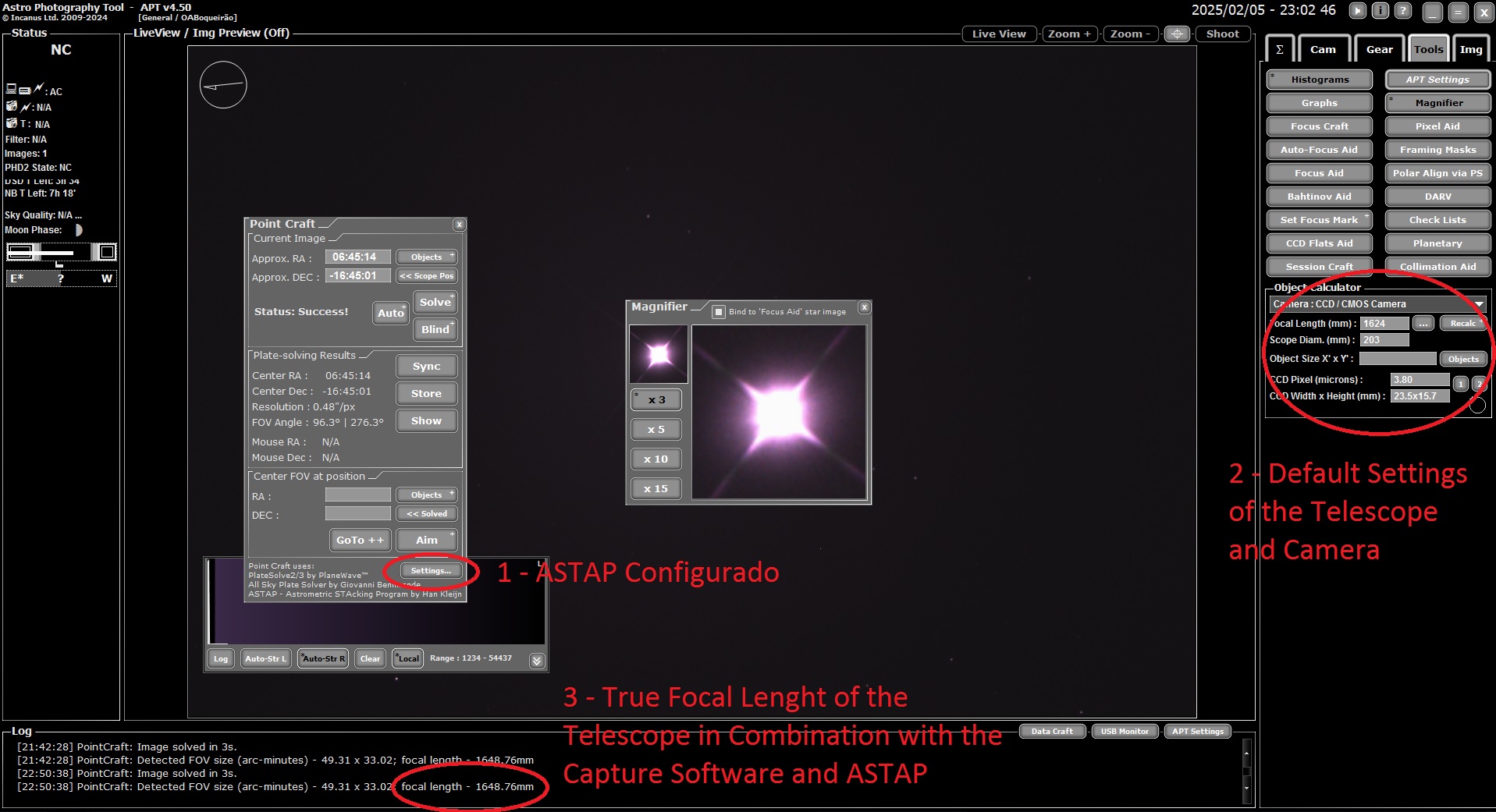
I have in 1 the ASTAP configured in the first image, as you can check. In the software calculator (point 2 at the right), I have the the manufacture camera and telescope settings, as you can see, mainly the camera's chip size and pixel size. The telescope in this situation is an RC with a native focal lenght of 1624mm and 203mm of aperture.
When I calculate using the software tool combined with ASTAP, it gives me after the camera shot the focal lenght as you can see in the point 3. In this case I need to readjust the optical train in order to have the proper and correct backfocus. The ASTAP solved in the software 1648.76mm, meaning that I need to reduce the focal lenght to the manufacture specifications of 1624mm.
If you where using a SCT C8, is the same thing. But insted of the 1624mm, is would be the 1280mm gaved by the focal reducer/flattner of the Celestron.
In the case of the SCT C8 + Celestron 0.63x reducer/flatnner, you adjust the backfocus until the software gives you the 1280mm or something really really close to that value. In my case I'm around 112.1mm of backfocus from the last element of the reducer/flatnner up to the camera's sensor, insted of the 105mm of backfocus given by Celestron.
I don't know if this helps to understand it.
You also can do it manually. Just upload the fit file from the camera, to the nova astrometry website (https://nova.astrometry.net/upload) and after the image is been solved, search for the pixel scale in Arc/Sec.
Then you do this math 206.265 x the camera pixel size / by the value of the pixel scale in Arc/Sec. given by the Astrometry website and you'll have the focal lenght. You can check in this image:
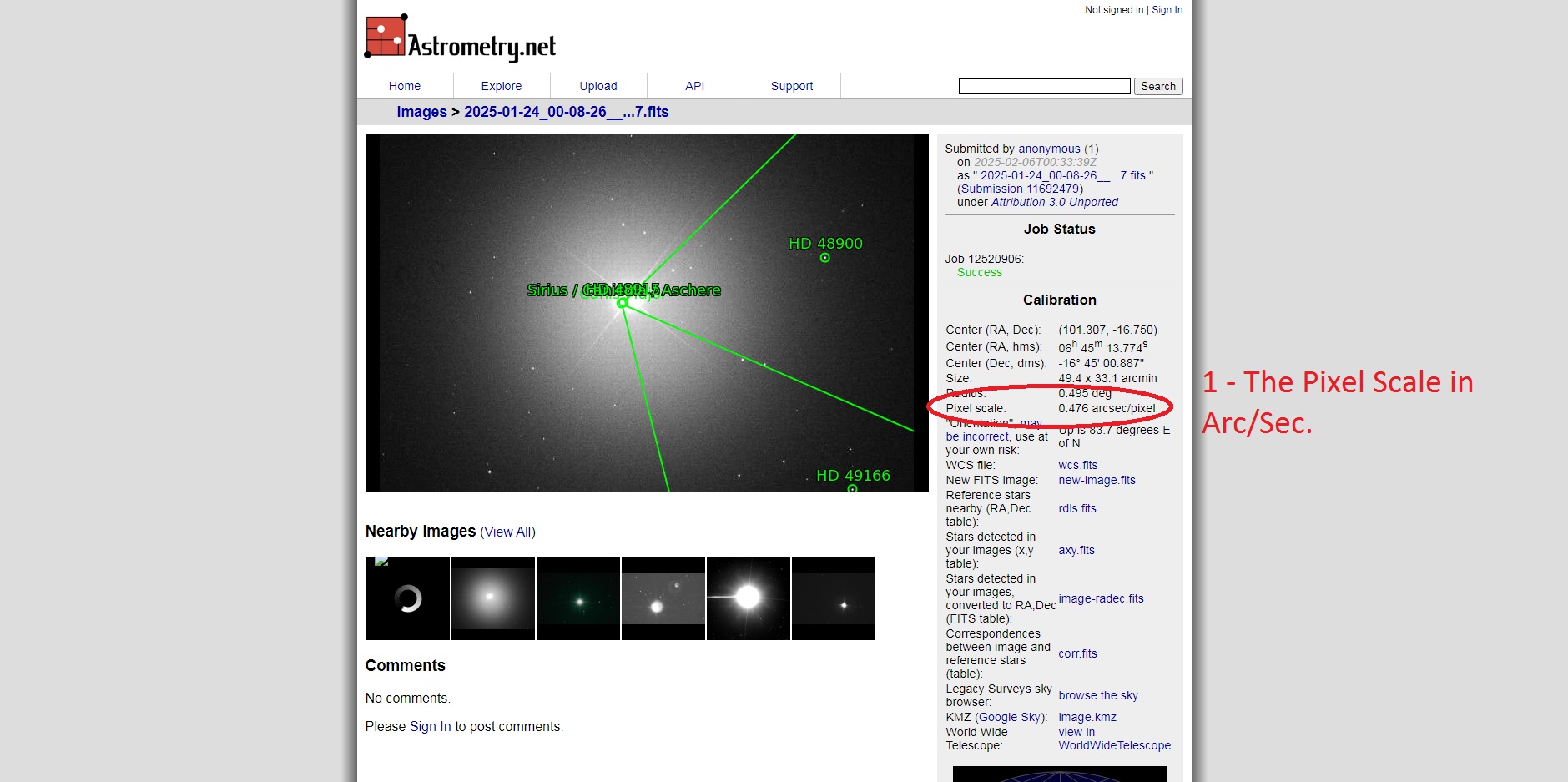
In this image particularly will be this way: 206.265 x 3.80um / 0.476 arcsec/pixel = 1646.65mm
The value 206.265 is fixed. The variables are the pixel size and the resolution in the fits file shooted by the camera in Arc/Sec. per pixel. But this is if you don't have any other way of doing it, you can do it manually.
Well If you have more questions, or you need further help, just let me know.
Regards,
Cesar
I think I didn't make myself clear regarding the use of ASTAP to calculate the backfocus. I use it as the plate solver in my capture software (I use the AstroPhotography Tools - APT) with some of Star databases in the ASTAP. Some of the libraries are H18, H17, D50, D05, etc. Hope this helps: https://sourceforge.net/projects/astap-program/files/star_databases
I'll leave two prints of my software in how I do it:


I have in 1 the ASTAP configured in the first image, as you can check. In the software calculator (point 2 at the right), I have the the manufacture camera and telescope settings, as you can see, mainly the camera's chip size and pixel size. The telescope in this situation is an RC with a native focal lenght of 1624mm and 203mm of aperture.
When I calculate using the software tool combined with ASTAP, it gives me after the camera shot the focal lenght as you can see in the point 3. In this case I need to readjust the optical train in order to have the proper and correct backfocus. The ASTAP solved in the software 1648.76mm, meaning that I need to reduce the focal lenght to the manufacture specifications of 1624mm.
If you where using a SCT C8, is the same thing. But insted of the 1624mm, is would be the 1280mm gaved by the focal reducer/flattner of the Celestron.
In the case of the SCT C8 + Celestron 0.63x reducer/flatnner, you adjust the backfocus until the software gives you the 1280mm or something really really close to that value. In my case I'm around 112.1mm of backfocus from the last element of the reducer/flatnner up to the camera's sensor, insted of the 105mm of backfocus given by Celestron.
I don't know if this helps to understand it.
You also can do it manually. Just upload the fit file from the camera, to the nova astrometry website (https://nova.astrometry.net/upload) and after the image is been solved, search for the pixel scale in Arc/Sec.
Then you do this math 206.265 x the camera pixel size / by the value of the pixel scale in Arc/Sec. given by the Astrometry website and you'll have the focal lenght. You can check in this image:

In this image particularly will be this way: 206.265 x 3.80um / 0.476 arcsec/pixel = 1646.65mm
The value 206.265 is fixed. The variables are the pixel size and the resolution in the fits file shooted by the camera in Arc/Sec. per pixel. But this is if you don't have any other way of doing it, you can do it manually.
Well If you have more questions, or you need further help, just let me know.
Regards,
Cesar
Helpful
I may be a little late to the party but I can share my experience.
I have a SCT 8" and use it mainly with a ZWO ASi533mc pro. Love the framing these 2 give.
I used to use the celestron 0.63x reducer, plainly aweful. You'll get a white-ish/washed out center with little detail and terrible near-edge corrections. After a lot of fighting and frustration, I went to Starizona SCT reducer, BEST DECISION EVER! My only regret was not doing it earlier. I have now full edge to edge correction on my 533 and also using a PlayerOne Poseidon C. You can see my M16 nebula with that reducer on my profile. If you don't mind me giving you advise, do yourself a favor and get the Starizona reducer, also pair it with the sv220 (svbony dual NB) filter and I guarantee you'll be very please with the results. Make sure your SCT is well aligned and collimated.
I have a SCT 8" and use it mainly with a ZWO ASi533mc pro. Love the framing these 2 give.
I used to use the celestron 0.63x reducer, plainly aweful. You'll get a white-ish/washed out center with little detail and terrible near-edge corrections. After a lot of fighting and frustration, I went to Starizona SCT reducer, BEST DECISION EVER! My only regret was not doing it earlier. I have now full edge to edge correction on my 533 and also using a PlayerOne Poseidon C. You can see my M16 nebula with that reducer on my profile. If you don't mind me giving you advise, do yourself a favor and get the Starizona reducer, also pair it with the sv220 (svbony dual NB) filter and I guarantee you'll be very please with the results. Make sure your SCT is well aligned and collimated.
Helpful Engaging
Jonathan Monestel:
I may be a little late to the party but I can share my experience.
I have a SCT 8" and use it mainly with a ZWO ASi533mc pro. Love the framing these 2 give.
I used to use the celestron 0.63x reducer, plainly aweful. You'll get a white-ish/washed out center with little detail and terrible near-edge corrections. After a lot of fighting and frustration, I went to Starizona SCT reducer, BEST DECISION EVER! My only regret was not doing it earlier. I have now full edge to edge correction on my 533 and also using a PlayerOne Poseidon C. You can see my M16 nebula with that reducer on my profile. If you don't mind me giving you advise, do yourself a favor and get the Starizona reducer, also pair it with the sv220 (svbony dual NB) filter and I guarantee you'll be very please with the results. Make sure your SCT is well aligned and collimated.
I’m about to use my old c8 with the celestron f6,3 and 533, did you stay in 105mm backfocus?
No, I no longer use the 6.3, I gave it away. Since I moved to the Starizona reducer it has a different backfocus requirement. It uses 90.3mm, they sell the adapter 35.3mm so all you need is the 55mm normally used in cameras, very handy.
The Antares 6.3 is the same as the Celestron 6.3. I can tell you the performance is really poor. If you don't want to throw your money to the garbage, go to high end instead of Antares or Celestron's 6.3, just my recommendation.
Here's an single light of 180s using the Celestron 6.3 and a ZWO ASI2600mc pro. Hard vignetting and details completely erased from the image, plus look at the stars on the edges. There is also a white-ish center that I couldn't figure out why at all. Moved to Starizona all issues went away immediately, so it was not the 8", it was the reducer.
Celestron C6.3 180s Bortle 7, Astronomik CLS v2
Stars are bad just bit away from the center and it was not backfocus, I tried 105mm, 127, 110, 100 no matter what I tried stars were bad always. 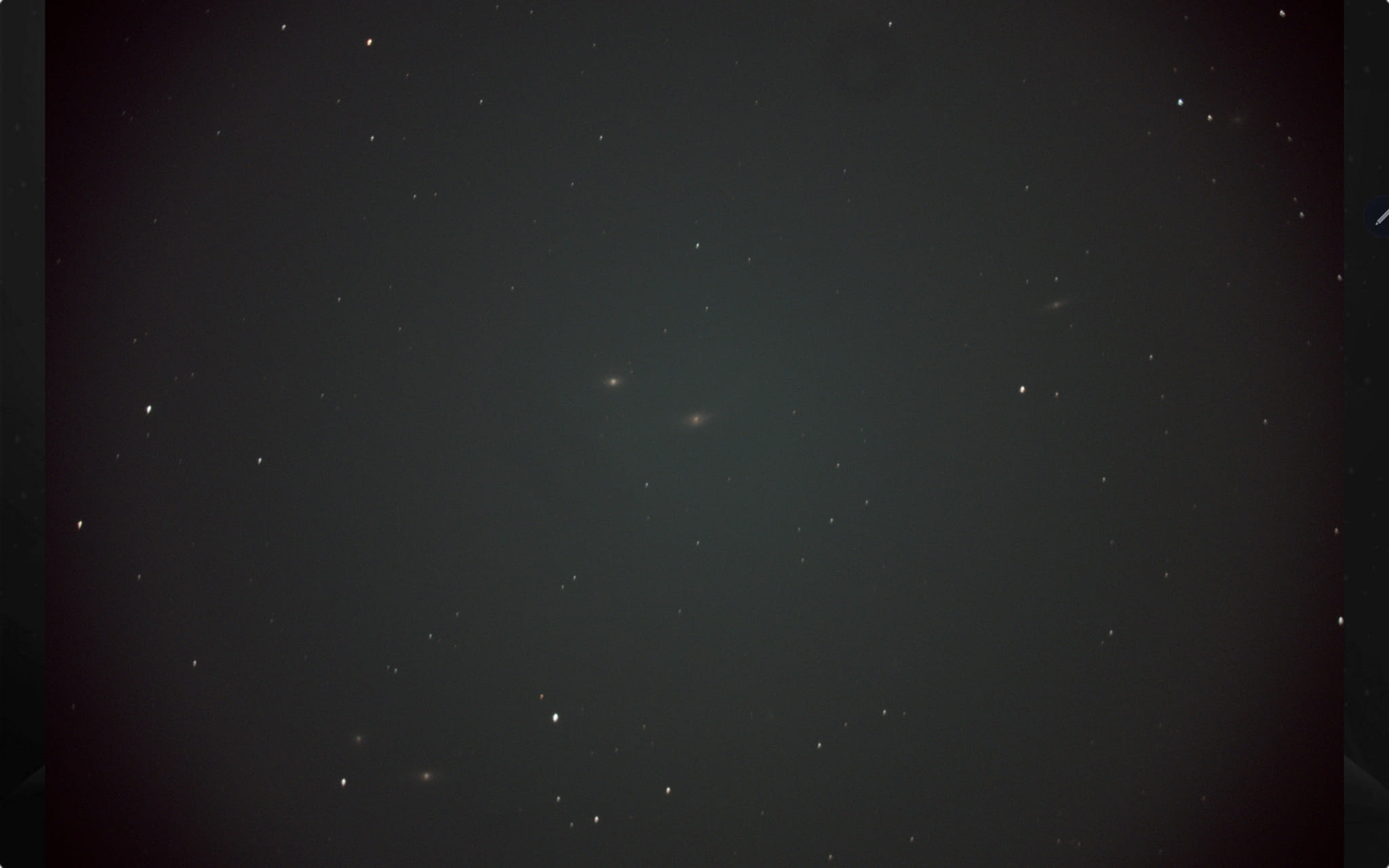
Starizona F7.1 180s Bortle 7, Astronomik CLS v2.
You can see the difference as night and day in the center (vignetting got reduced since it's a 533mc pro - smaller chip)
Stars are now flat end to end
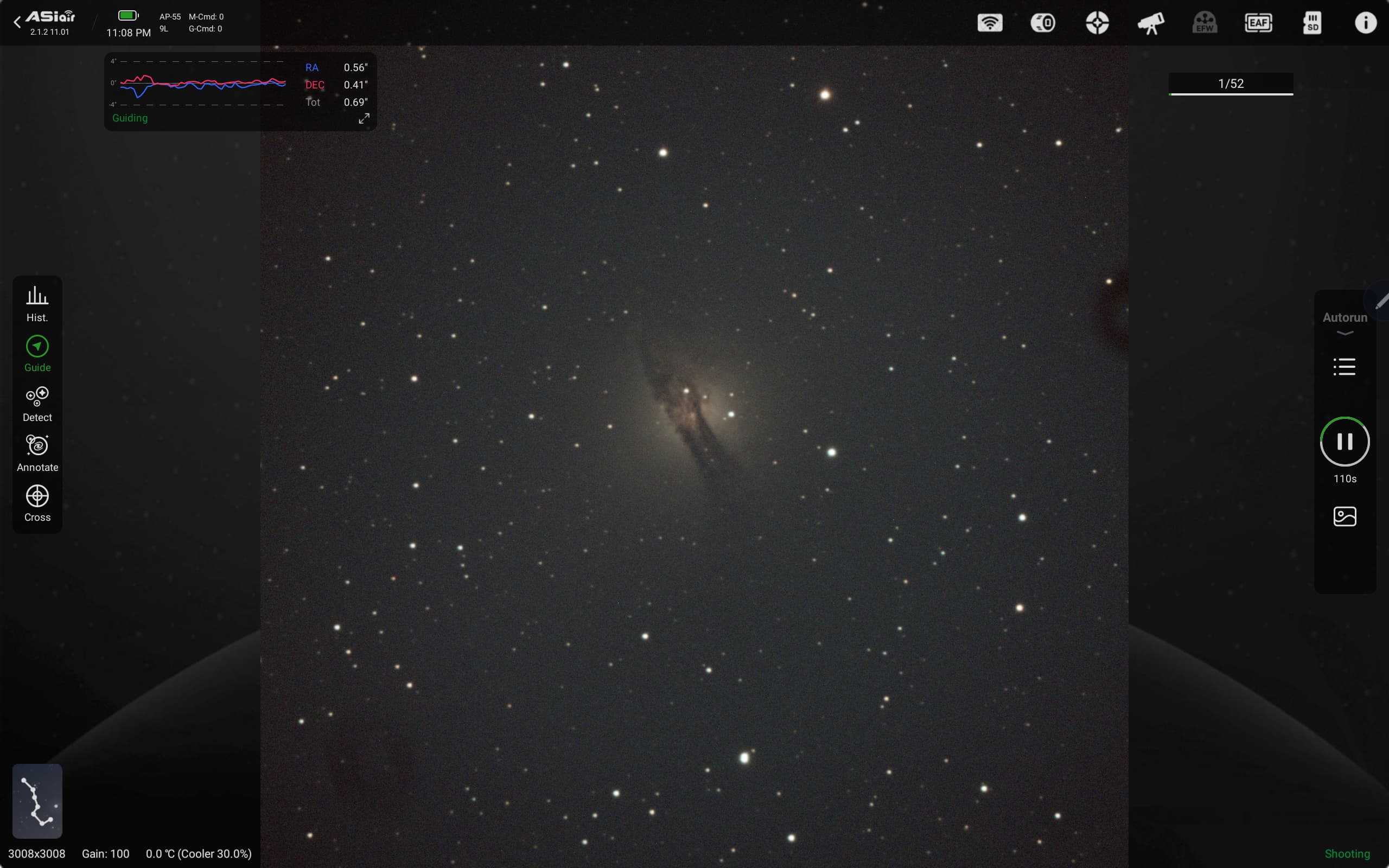
Here's an single light of 180s using the Celestron 6.3 and a ZWO ASI2600mc pro. Hard vignetting and details completely erased from the image, plus look at the stars on the edges. There is also a white-ish center that I couldn't figure out why at all. Moved to Starizona all issues went away immediately, so it was not the 8", it was the reducer.
Celestron C6.3 180s Bortle 7, Astronomik CLS v2
Stars are bad just bit away from the center and it was not backfocus, I tried 105mm, 127, 110, 100 no matter what I tried stars were bad always. 

Starizona F7.1 180s Bortle 7, Astronomik CLS v2.
You can see the difference as night and day in the center (vignetting got reduced since it's a 533mc pro - smaller chip)
Stars are now flat end to end

Helpful
Jay Sanchez:
You got me interested in the Starizona focal reducer for my old Meade SCT 8".
Not going to lie, it's a bit expensive but 100% worth it. Make sure to buy all required adapters to make it work. (2" visual back and starizona extension for 55mm)
Remember the thrust of the original post was that it is for a small sensor. Specifically the 585 which is 3840x2160, 2.9 micron pixels. That's a working FOV of just 17.1' x 30.3' with a C8 at F/6.3. I am really wondering when working at that FOW if most of the advantages that the Starzona reducer provides would really matter?
Helpful Insightful Respectful Concise Engaging
Tony Gondola:
Remember the thrust of the original post was that it is for a small sensor. Specifically the 585 which is 3840x2160, 2.9 micron pixels. That's a working FOV of just 17.1' x 30.3' with a C8 at F/6.3. I am really wondering when working at that FOW if most of the advantages that the Starzona reducer provides would really matter?
Yes, that's why I shared my 533. It's a small chip too. The main point is the 6.3x quality is very low and no matter what camera you use, your images will suffer. Now if you want to try it anyway, of course you can.
andrea tasselli Frequent contributor
Feb 20, 2025
The Celestron (or Meade, for that matter, which is just a copy) was poor even 20 years ago with those smallish sensors with largish pixels and that hasn't changed. It was designed for the film era and that's it. Some worked better than others but my 2 copies weren't up to scruff with the ICX285. Sold the lot off, with the C8.
Yeah you can, just remember stars will not be corrected on the edges, so cropping may be needed and you'll may hit the object, example m20 it barely fits at 2000mm.
andrea tasselli Frequent contributor
Feb 21, 2025
Classical SCTs (both mirrors spherical) have a rather poor field correction, roughly equivalent to that of newtonian of the same focal ratio of the secondary but with worse astigmatic field curvature (and zonal error). I estimate that at 10mm from the optical axis the spot size would be around 25 um, which is rather poor by today's standard but acceptable by photographic standard (film). It has been postulated that some SCTs (Meade potentially, Takahashi) had a slight retouching (aspherization) of the secondary to improve off-axis performance but I have no proof positive that this is in fact generally true.
Well Written Helpful Insightful Concise
There might be something to that. I had a private tour of the Celestron facility in Torrance about 86'. Even had lunch with Tom Johnson but that's another story. At that time, all of the optical correction was done by figuring the secondary. There was some matching I think with correctors and primaries but no figuring. That said, I've seen such variation in performance from one SCT to the next that it makes you wonder just how loose QC was. Talking about the older classic designs of course. Even with perfect collimation some were tack sharp and others, real mush dogs. Unless you were able to star test and hand pick, it was a real lottery.
Well Written Helpful Insightful Engaging
Jonathan Monestel:
The Antares 6.3 is the same as the Celestron 6.3. I can tell you the performance is really poor. If you don't want to throw your money to the garbage, go to high end instead of Antares or Celestron's 6.3, just my recommendation.
Here's an single light of 180s using the Celestron 6.3 and a ZWO ASI2600mc pro. Hard vignetting and details completely erased from the image, plus look at the stars on the edges. There is also a white-ish center that I couldn't figure out why at all. Moved to Starizona all issues went away immediately, so it was not the 8", it was the reducer.
Celestron C6.3 180s Bortle 7, Astronomik CLS v2
Stars are bad just bit away from the center and it was not backfocus, I tried 105mm, 127, 110, 100 no matter what I tried stars were bad always. 
Starizona F7.1 180s Bortle 7, Astronomik CLS v2.
You can see the difference as night and day in the center (vignetting got reduced since it's a 533mc pro - smaller chip)
Stars are now flat end to end
what if a noob with no budget was using a 533 and oag?
Would a cheapo 0.63 clone be ok ?
I'm just starting at F10 with a C6 and struggling